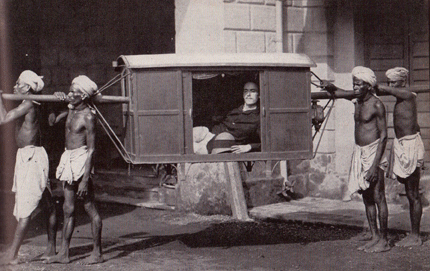
“Palkee or palanquin and bearers, Calcutta. Although the palanquin is no longer used for travel in India, in the days before the railroad it was of primary importance. The Kahars and other castes of palanquin bearers are thought to have been the prototypes of the bearers who are assigned to European sojourners in India today.”
During World War II the Smithsonian Institution issued a number of “War Background Studies.” I recently came across #18 in this series entitled Peoples of India by William H. Gilbert, Jr. (Washington D.C.: Smithsonian Institution, April 29, 1944). The image on Plate 6, reproduced above, sets the tone for this non-war zone. I was struck by the archaic presentation of images and the overtly Orientalist writing of Gilbert, who is billed as a “Specialist in Sociology and Anthropology, Legislative Reference Series, Library of Congress.” The Introduction (pp. 1-2) sets out in words the image vividly portrayed above. Read this for yourself and consider the various ways in which the author’s rhetoric both romanticizes India and justifies the colonial enterprise. I will make my own comments in a succeeding post, but I welcome comments posted here.
Introduction
Hardly any other country in the world can make a stronger claim on man’s inherent desire for the unique and the romantic than India. Even in antiquity it was widely reputed for its splendor and incredible riches, for bejeweled sovereigns and wondrous sweet spices. The desire to see and obtain these things led many a traveler and trader to the Indian shores. Throughout Medieval times the wonder tales persisted of this fabulous land, and, stirred by the accounts that they had heard of the riches in the east, great explorers such as Vasco da Gama and Christopher Columbus set out in search of better sea routes for reaching this realm. The strength of this legend is to be seen in the fact that we still call the aboriginal natives of America “Indians.”
Today, even though Europeans have been in India as rulers and traders for several centuries, there remains an air of mystery and strange fascination int he weird events and unusual scenes which are to be encountered or witnessed in that country. The innumerable villages swarming with human life, the grotesque and incredibly decorated temples and shrines attended by exotic priests, the brilliantly colorful processions and fairs, and the splendid durbars or court reviews, continue to cast a spell over even the most blase of travelers.
But there is, in addition to the romantic, still another and in some respects more important aspect of India which makes it imperative for the serious student to become better acquainted with it. This is India’s vital role in the global strategy of contemporary world politics. World planners and militarily minded geopoliticians, such as Homer Lea and Karl Haushofer, have considered India’s role as basic int he control of world seaways and sea power. Strategically situated as it is, relative to the Indian Ocean and the shores of southern Asia, the protection of India has been assigned a dominating role in the world politics of Great Britain for the last 150 years. India is considered by some writers to be the keystone to the survival of the British Empire and its political center of gravity. The advance of Napoleon into Egypt involved a prolonged struggle on the part of England to maintain her seaways to India, while the march of Russia into central Asia during the nineteenth century and toward the control of the Bosphorus, on the way to India, preceded the Crimean War. In the last World War the German-dominated “Berlin to Bagdad” Railway pointed only too clearly at the British life line to India. The fortifications of the great British base at Singapore and the projected completion of the “Cape to Cairo” Railroad were moves designed to protect the flanks of the great ocean domain abutting upon India. The latest threat to India, the Japanese occupation of the East Indies and Burma during the present war, has been the most effective thrust in many years against British dominance of the Indian subcontinent. an additional complication to the situation is offered by the international implications of the internal stresses within India between Muslims and Hindus, between British India and the Indian States, and between Caste Hindus and Untouchables.
To be continued…